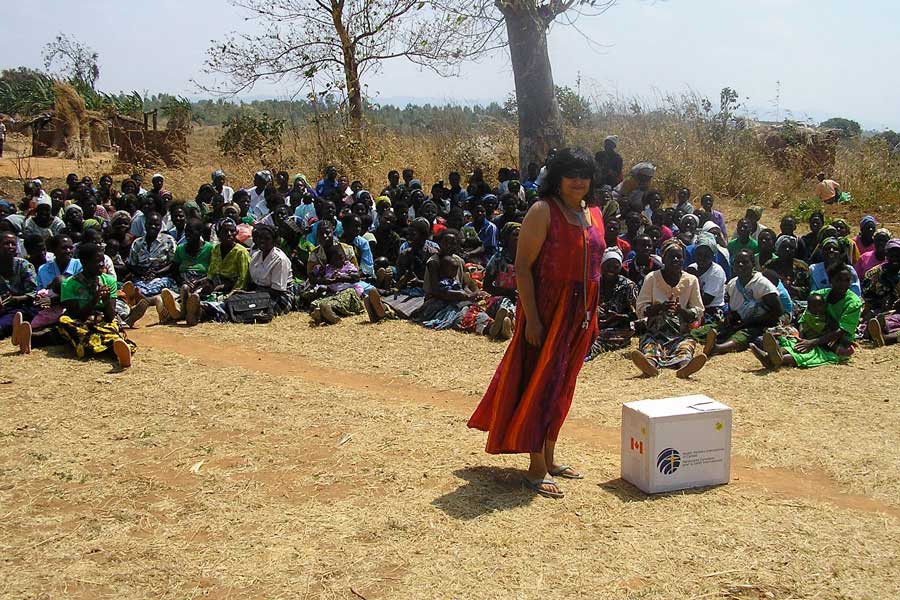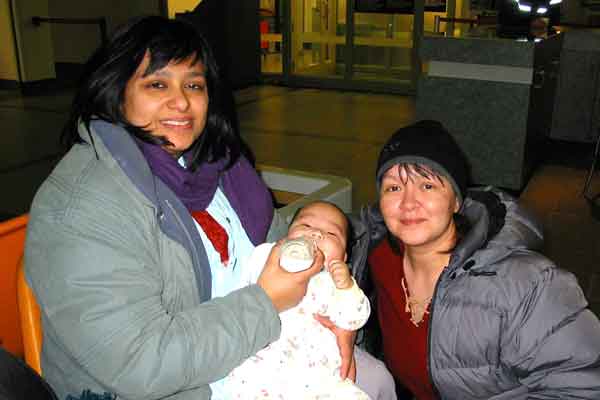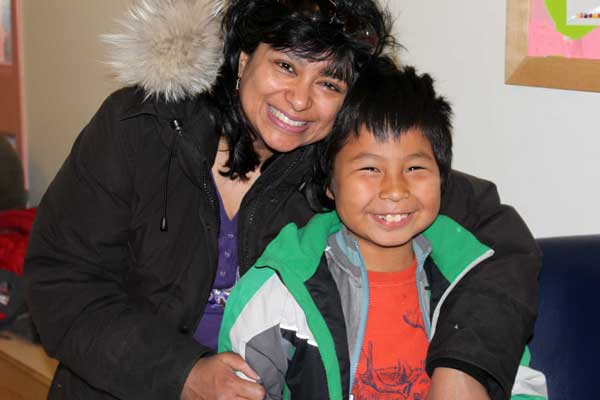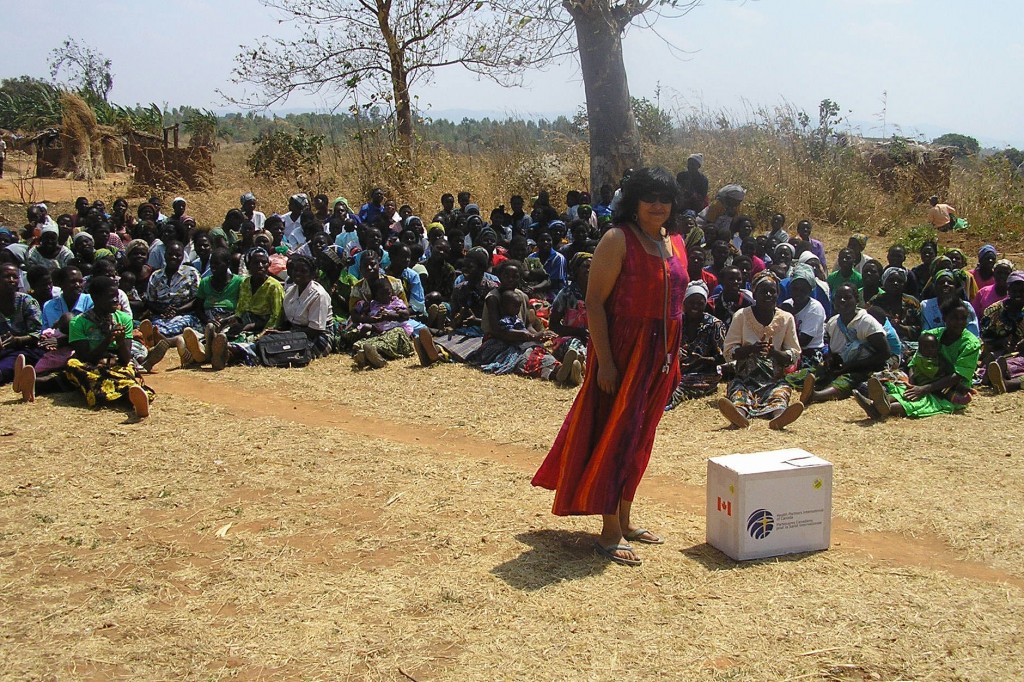Written by Tristan Bronca on August 31, 2014
A vocation born on a bridge in India leads Dr. Anna Banerji to the Canadian Arctic
In 2009, word got out that Dr. Banerji would open a small clinic in a village in Malawi and 300 people lined up to meet her. “I saw 200 kids that day in a cement shelter with no running water, electricity or examination table,” she later wrote.
When Dr. Anna Banerji was 11 and visiting Calcutta for the first time, her mother took her across the city’s famous Howrah Bridge. It is one of the busiest bridges in the world and that morning back in the 1976 was no different. The walkways were jammed with pedestrians and the middle lane ways were crowded by goats, cows, trucks, and rickshaws, all of them trying to make their way to or from the Howrah train station at the opposite end.
Within that chaotic scene, she noticed a man on side of the road, nearly naked and bleeding from his head. “He was lying in the gutter and nobody stopped,” she remembered. “All of Calcutta just moved forward.”

Dr. Banerji openning a small clinic in a village in Malawi – 2009
It was a moment of almost eerie clear-sightedness that, by her own admission, changed her life. Right then and there, she decided she would become a doctor and devote her life to improving international health.
Today, Dr. Banerji is the Director of Global and Indigenous Health, Continuing Professional Development, at the University of Toronto;; an appointment she juggles with two professorships at the university and eight other appointments at Toronto hospitals. She works primarily with refugee children and, having visited more than 50 countries, became a tropical and infectious disease specialist to optimize her impact in those parts of the world.
Her 27-page CV is scattered with awards (the Order of Ontario and the Diamond Jubilee Medal both in 2012), grants (the Canadian Infectious Disease Society/Bayer Canada) and research that spans from the Arctic to Asia.
But the reason for her acclaimed body of work is also, perhaps, the aspect least recognized by those outside her field: her patients. Dr. Banerji ministers to populations that are among the world’s most vulnerable, disadvantaged and ignored.
In 1995, her work brought her closer to home when she travelled to the Arctic for the first time. She noticed unusually high rates of lower respiratory tract infections (LRTIs) in Inuit children. She began a study later published in the Canadian Medical Association Journal (June 26, 2001) that revealed nearly half the babies born on Baffin Island end up in the hospital with lung infections in their first six months of life. But this wasn’t news to people living there. Soon Nunavut’s Chief Medical Officer of Health (CMOH) recognized her expertise in the area and commissioned further studies.
“She called me saying, ‘We know the rates are high, but why?’” Dr. Banerji said.
The answer might, in part, explain how an internationally minded doctor ended up settling in the Canadian north. A follow-up paper in the Pediatric Infectious Disease Journal (August 2009) showed the factors contributing to these swollen rates were similar to those affecting other vulnerable populations around the world: living in overcrowded conditions, exposure to cigarette smoke and lack of breastfeeding. Dr. Banerji also mentioned that conditions such as dental abscesses, malnutrition and those resulting from physical trauma can be just as common among northern populations as they are among those living in poverty-stricken regions of the globe—problems made worse by language and cultural barriers that inhibit access to care.
In other words, it was clear to Dr. Banerji that these people living on Canadian soil had more in common with patient populations half the world away than they did with their fellow Canadians.
“You know, when we think of global health, we think of Australian Aborigines, but anyone an hour south of here would say the Inuit is an (equally) unique population,” she pointed out, “and they’re in our own backyard.”
Still, despite the “phenomenal numbers” that have come out of the several research papers she’s authored, Dr. Banerji struggled to get many of them published;; evidence, she said, of the systematic neglect faced by Indigenous populations.
In 2009, Dr. Banerji began a study to track almost every birth in northern Quebec, Nunavut and the Northwest Territories over the next year and a half—an unprecedented sample size in that part of the world. In that time, more than 25% of infants in her sample were hospitalized with a lower respiratory tract infection. A separate paper on the same study published in the International Journal of Circumpolar Health (August 2013) revealed the cost of each hospitalization in Nunavut averaged $55,265 after transportation, evacuation and inpatient costs. A vaccine called palivizumab has been shown to prevent RSV admissions but is currently administered only to premature babies or those with chronic lung conditions. But, as she demonstrated in another article published in the Pediatric Infectious Disease Journal (also in August 2009), administering the drug to more infants in certain communities would reduce hospital admissions and the massive expenditures on treatment.

Pictured with her adopted son, Nathan, and foster mother, Monica, in 2004.
But, during a recent submission, one of the editors (of a journal The Medical Post has agreed not to name) “basically said there wasn’t enough interest in this,” she said. “He didn’t think the impact factor was high enough.” She referred the reluctant editor to one of her 2009 “risk factor” article in the Pediatric Infectious Disease Journal which, perhaps not coincidentally, had also been rejected by the same journal. It had been cited 48 times, prompted mainstream media coverage and, along with the companion paper on the cost of hospitalizations, led to changes in the Canadian pediatric guidelines. “That’s a high impact paper,” she said.
She has faced other difficulties too. Apart from a very public spat with the CMOH in one of the territories, there are a number of stumbling blocks that the public doesn’t see splashed across the media. The first is cost. The price of a return trip ticket to parts of the Arctic can be as expensive as flying to Europe. That, coupled with shortage of manpower, means studies can cost hundreds of thousands of dollars and researchers often have trouble leveraging the health-care workers in the region because many facilities are already understaffed.

Dr. Banerji and Nathan during their trip to Iqaluit in 2013.
The populations also tend to be small and difficult to access, meaning researchers don’t get the same enrolment as you do in other parts of the world;; problems that are further exacerbated by the cultural mistrust that lingers after centuries of trauma and ill-will.
In spite of this, Dr. Banerji has managed to forge a number of strong connections to the people she’s dedicated to helping, some of which have even bubbled over into her private life. Perhaps the most obvious example of this is her son, Nathan.
In the early years working in the Arctic, ” I would review charts of LRTI admissions and occasionally I would come across a child who was found in the snow in their diapers while the parents were out drinking,” she began. “It broke my heart. So I went to an Inuit elder named Towaga and I said one of these days I want to adopt an Inuit child.”
Nine years later, on December 28, 2004. Dr. Banerji was driving her daughter to a play date just days before she was scheduled to fly to Indonesia to assist with the Boxing Day tsunami rescue effort. A resident of hers named Dr. Barry Pakes, who was doing a locum on Baffin Island, called to say her name had come up at rounds that morning. A new mother had approached Towaga to give her baby up for adoption. When Towaga mentioned how Dr. Anna always wanted to adopt an Inuit child, Dr. Pakes piped up. “Dr. Anna Banerji?” he would later remember. He had her number on speed dial. “I nearly crashed my car when they called,” she remembered.
While Dr. Banerji was excited by the news, the adoption fell through but the call had put her in touch with the local director of adoptions. Three weeks later, she flew up north to pick up a six-month-old baby that had been stuck in the foster system.
“I didn’t know the age or if it was a boy or a girl,” she chuckled. She brought the little boy home to a somewhat confused four-year-old sister—she would later tell her class that her “mummy bought a baby at the airport,” Dr. Banerji said—and a very obviously unprepared household. “We were renovating,” she said, “I had my bathroom sink in the middle of the living room.”
Now the baby she first saw in a blue snowsuit at Iqaluit airport, Nathan, is nine-years-old and Dr. Banerji has something more than a professional interest in the Arctic. Every two years, on one of her trips to Nunavut, he goes with her. “I want him to know about his heritage,” she said.
Right now, Dr. Banerji said there are huge discrepancies between Indigenous health care and care in other parts of the country. She said those two shortcomings play a huge role in this disparity but, if addressed they could knock down at least some of the barriers to equitable care.
“You know, two days is not a lot to learn about the culture,” she said. “but it’s a start.”
